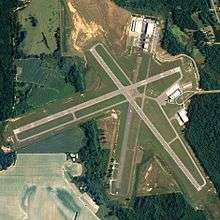Troy Municipal Airport
Troy Municipal Airport (IATA: TOI, ICAO: KTOI, FAA LID: TOI) is a city-owned public-use airport located four nautical miles (4.6 mi, 7.4 km) northwest of the central business district of Troy, a city in Pike County, Alabama, United States.[1] It is included in the FAA's National Plan of Integrated Airport Systems for 2011–2015, which categorized it as a general aviation facility.[2]
Troy Municipal Airport | |||||||||||||||
|---|---|---|---|---|---|---|---|---|---|---|---|---|---|---|---|
 NAIP aerial image, 2006 | |||||||||||||||
| Summary | |||||||||||||||
| Airport type | Public | ||||||||||||||
| Owner | City of Troy | ||||||||||||||
| Serves | Troy, Alabama | ||||||||||||||
| Elevation AMSL | 398 ft / 121 m | ||||||||||||||
| Coordinates | 31°51′38″N 086°00′44″W | ||||||||||||||
| Map | |||||||||||||||
 TOI Location of airport in Alabama | |||||||||||||||
| Runways | |||||||||||||||
| |||||||||||||||
| Statistics (2010) | |||||||||||||||
| |||||||||||||||
History
It was activated on 11 January 1942 as Troy Auxiliary Airfield, a satellite airfield for the United States Army Air Forces Maxwell Field near Montgomery. It was known as Maxwell AAF Aux No. 4 - Troy (aka Troy No. 5).
The airfield also conducted basic flying training throughout the war. Flying training was performed with Fairchild PT-19s as the primary trainer. It also had several PT-17 Stearmans and a few P-40 Warhawks assigned. It was transferred as inactive to the US Army Corps of Engineers on 1 April 1946 with the drawdown of AAFTC's pilot training program.
The airfield was turned over to civil control through the War Assets Administration (WAA).[3][4][5]
Facilities and aircraft
Troy Municipal Airport covers an area of 501 acres (203 ha) at an elevation of 398 feet (121 m) above mean sea level. It has two asphalt-paved runways: 14/32 measuring 5,022 by 100 feet (1,531 by 30 meters) and 7/25 measuring 5,009 by 100 feet (1,527 by 30 meters).[1] The tower and radar facilities are run by U.S. Army air traffic controllers. The airport is dominated by student pilots flying TH-67 helicopters from Fort Rucker between the times of 0800–1030L and 1400–1600L.
For the 12-month period ending August 3, 2010, the airport had 69,088 aircraft operations, an average of 189 per day: 59% general aviation and 41% military. At that time there were 39 aircraft based at this airport: 74% single-engine, 18% multi-engine and 8% jet.[1]
References
- FAA Airport Master Record for TOI (Form 5010 PDF). Federal Aviation Administration. Effective 30 June 2011.
- National Plan of Integrated Airport Systems for 2011–2015: Appendix A (PDF, 2.03 MB). Federal Aviation Administration. Updated 4 October 2010.
-

- Shaw, Frederick J. (2004), Locating Air Force Base Sites History’s Legacy, Air Force History and Museums Program, United States Air Force, Washington DC, 2004.
- Manning, Thomas A. (2005), History of Air Education and Training Command, 1942–2002. Office of History and Research, Headquarters, AETC, Randolph AFB, Texas ASIN: B000NYX3PC
External links
- FAA Terminal Procedures for TOI, effective August 13, 2020
- AC-U-KWIK information for KTOI
- Resources for this airport:
- FAA airport information for TOI
- AirNav airport information for KTOI
- ASN accident history for TOI
- FlightAware airport information and live flight tracker
- NOAA/NWS weather observations: current, past three days
- SkyVector aeronautical chart, Terminal Procedures